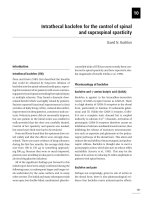Lecture Math for the pharmacy technician Concepts and calculations Chapter 11 – Lynn M. Egler, Kathryn A. Booth
Bạn đang xem bản rút gọn của tài liệu. Xem và tải ngay bản đầy đủ của tài liệu tại đây (1.38 MB, 42 trang )
Math for the Pharmacy Technician:
Concepts and Calculations
Egler • Booth
Chapter 11: Operational
Calculations
McGraw-Hill
©2010 by the McGraw-Hill Companies, Inc All Rights Reserved
Operational Calculations
McGraw-Hill
©2010 by the McGraw-Hill Companies, Inc All Rights Reserved
11-3
Learning Objectives
When you have successfully completed Chapter 11, you
will have mastered skills to be able to:
Calculate overhead costs
Calculate profits
Calculate discount amounts
McGraw-Hill
©2010 by the McGraw-Hill Companies, Inc All Rights Reserved
11-4
Learning Objectives
(con’t)
Calculate average wholesale price
(AWP)
Calculate inventory turnover rate
Calculate depreciation
Demonstrate understanding of
capitation fee and AWP plus fee
McGraw-Hill
©2010 by the McGraw-Hill Companies, Inc All Rights Reserved
11-5
Introduction
As a pharmacy technician you need to be
familiar with the aspects of the day-to-day
operations of the pharmacy.
The costs involved in running the
pharmacy are many.
While providing a service to the patient is
important, the pharmacy must also make
money in order to stay in business.
McGraw-Hill
©2010 by the McGraw-Hill Companies, Inc All Rights Reserved
General Business
Considerations
11-6
All businesses have costs associated
with day-to-day operations.
The pharmacy’s income earned from
sales must be higher than the
operational costs in order for the
pharmacy to be profitable.
McGraw-Hill
©2010 by the McGraw-Hill Companies, Inc All Rights Reserved
11-7
General Business
Considerations (cont.)
Multiple operational calculations are
used to run a profitable pharmacy.
You will learn how to calculate the
following:
Overhead costs
Profits
Gross profits
Net profits
Discounts
McGraw-Hill
©2010 by the McGraw-Hill Companies, Inc All Rights Reserved
11-8
Overhead
The pharmacy’s overhead is all costs
associated with the pharmacy’s business
operations. These costs include:
Employee salaries
Rent
Utility bills
Insurance premiums
Inventory/Supplies
Discounts
Sale items
McGraw-Hill
©2010 by the McGraw-Hill Companies, Inc All Rights Reserved
11-9
Overhead
(con’t)
The total cost of the overhead is used to
calculate the pharmacy’s profit.
Example:
Annual Overhead Costs
Employee salaries
Rent
Utilities
Insurance
Inventory/supplies
Annual overhead total
McGraw-Hill
$125,000.00
$24,000.00
$12,000.00
$6,000.00
+$732,000.00
$899,000.00
©2010 by the McGraw-Hill Companies, Inc All Rights Reserved
11-10
Profits
A profit is the difference between
overhead expenses and income
earned from sales. To calculate a
profit you subtract the pharmacy’s
overhead costs from the income
earned from sales.
McGraw-Hill
©2010 by the McGraw-Hill Companies, Inc All Rights Reserved
Review and Practice
Profits
11-11
Annual sales
$1,548,370.00
Annual overhead costs – $899,000.00
Annual profit
$649,370.00
McGraw-Hill
©2010 by the McGraw-Hill Companies, Inc All Rights Reserved
11-12
Gross Profit
Gross Profit is the difference of the
purchase price the pharmacy paid for
products, for example medication,
and markup price, which is the selling
price.
To calculate the gross profit you
subtract the pharmacy’s purchase
price from the selling price.
McGraw-Hill
©2010 by the McGraw-Hill Companies, Inc All Rights Reserved
Review and Practice
Gross Profit (con’t)
11-13
Azithromycin 250 mg 6 tablets (Z-pak)
Selling price
$13.99
Purchase price
–$4.57
Gross profit
$9.42
McGraw-Hill
©2010 by the McGraw-Hill Companies, Inc All Rights Reserved
11-14
Net Profit
Net Profit is the difference of the
selling price, and the purchase price
plus a dispensing fee, which is used
to offset the overhead costs used to
fill prescriptions.
McGraw-Hill
©2010 by the McGraw-Hill Companies, Inc All Rights Reserved
11-15
Net Profit
(con’t)
The dispensing fee per prescription is
determined by each pharmacy on the
basis of the company’s profit needs.
It can be a set fee or a percentage.
To determine the net profit, you
subtract the purchase price and the
dispensing fee from the selling price.
McGraw-Hill
©2010 by the McGraw-Hill Companies, Inc All Rights Reserved
Review and Practice
Net Profit (con’t)
Azithromycin 250
Selling price
Purchase price
Dispensing fee
Net profit
McGraw-Hill
11-16
mg 6 tablets (Z-pak)
$13.99
–$4.57
–$4.00
$5.42
©2010 by the McGraw-Hill Companies, Inc All Rights Reserved
11-17
Discount
A discount is a reduced price from
the normal selling price.
Drug manufacturers may offer the
pharmacy a discount for purchasing
large quantities of certain
medications.
The pharmacy may also offer
discounts to its customers.
McGraw-Hill
©2010 by the McGraw-Hill Companies, Inc All Rights Reserved
11-18
Discount
(con’t)
To determine a discounted price, you
multiply the selling price by the
discount percentage, which will give
you discount amount, then you
subtract the discount amount from
the selling price.
McGraw-Hill
©2010 by the McGraw-Hill Companies, Inc All Rights Reserved
Review and Practice
Discount (con’t)
11-19
The selling price for 1 bottle of 1000 tablets of
medication is $50.00. For orders of 5 bottles
or more the manufacturer offers a 10 percent
discount. What is the discounted price for 1
bottle?
Solution:
1. Multiply the selling price by the discount percentage.
2. Subtract the discount amount from the selling price.
$50.00
–$5.00
$45.00
The discounted price is $45.00
McGraw-Hill
©2010 by the McGraw-Hill Companies, Inc All Rights Reserved
11-20
Inventory
A detailed list of all items for sale and
their cost is called an inventory.
The pharmacy must maintain an
accurate inventory list.
It is extremely important to maintain
adequate amounts of medications
and supplies such as pill bottles,
labels, and prescription leaflets.
McGraw-Hill
©2010 by the McGraw-Hill Companies, Inc All Rights Reserved
11-21
Inventory
(con’t)
Keeping the inventory at optimal
levels helps to ensure prescriptions
are filled and that medications move
off the shelf quickly.
To maintain a balanced profitable
inventory, the value of inventory on
hand should not exceed the cost of
items sold during a specified time
frame.
McGraw-Hill
©2010 by the McGraw-Hill Companies, Inc All Rights Reserved
11-22
Turnover
Turnover is the number of times an
item is sold from inventory. When a
pharmacy opens, there is an initial
cost to stock it, and then there is a
cost to maintain the stock based on
the pharmacy’s sales.
McGraw-Hill
©2010 by the McGraw-Hill Companies, Inc All Rights Reserved
11-23
Turnover
(con’t)
To determine the turnover rate you
simply divide the annual inventory
purchases by the average inventory
value.
Annual inventory purchases
= turnover rate
Average inventory value
McGraw-Hill
©2010 by the McGraw-Hill Companies, Inc All Rights Reserved
Review and Practice
Turnover (con’t)
11-24
If the pharmacy’s average current stock on hand is
worth $200,000.00, that is the average inventory
value.
Determine the turnover rate.
Annual inventory purchases
= turnover rate
Average inventory value
1, 000, 000.00
=5
200, 000.00
Turnover rate = 5
McGraw-Hill
©2010 by the McGraw-Hill Companies, Inc All Rights Reserved
11-25
Depreciation
Depreciation is a decrease in the
value of an asset based on the age of
the asset in relation to its estimated
life.
The depreciation value is calculated by
using the value of the item when it is no
longer usable or when it is considered
disposable.
McGraw-Hill
©2010 by the McGraw-Hill Companies, Inc All Rights Reserved









